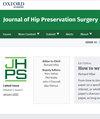与股骨后倾患者相比,股骨后倾和髋关节后撞击增加的成年患者股骨去旋截骨后足趾减少
IF 1.4
4区 医学
Q3 ORTHOPEDICS
引用次数: 2
摘要
摘要足趾内侧与股骨高位内翻(FV)相关,而足趾外侧与股骨后倾相关。因此,我们报告了(i)足部进展角(FPA),(ii)内趾和外趾的患病率,以及(iii)接受股骨旋转截骨(FDO)治疗的患者的临床结果。我们对20名接受单侧FDO治疗的患者(20髋)进行了回顾性分析(2017-18)。其中14例患者FV升高,6例患者发生股骨后倾。随访时间平均为1 ± 1. 年。所有患者都进行了最少的1年随访,平均年龄为29岁 ± 8. 年。FV增加的患者(FV > 35°)后撞击试验呈阳性,平均FV为49 ± 11°(Murphy法)。6名股骨后倾角(FV)患者 < 10°)的前撞击试验呈阳性,平均FV为5 ± 4°。术前和随访时使用Gaitrite系统进行仪器步态分析,以测量FPA,并与18名健康无症状志愿者(36英尺,平均年龄29岁)的对照组进行比较 ± 6. 年)。(i) 平均FPA显著增加(P = 0.006)从术前1.3 ± 7°至4.5 ± 随访时FV增加的患者为6°,与对照组相比没有显著差异(4.0 ± 4.5°)。(ii)对于FV增加的患者,从术前(5名患者)到随访(2名患者),趾内活动减少。从术前(两名患者)到随访(无患者),股骨后倾患者的趾外活动减少。(iii)所有患者的主观髋关节价值均显著增加(P < 0.001)。WOMAC当时12岁 ± 随访得8分。接受FDO的FV增加的患者走路时足趾较少。FDO有可能减少内向和外向,并提高随访时的主观满意度。本文章由计算机程序翻译,如有差异,请以英文原文为准。
Less in-toeing after femoral derotation osteotomy in adult patients with increased femoral version and posterior hip impingement compared to patients with femoral retroversion
ABSTRACT In-toeing of the foot was associated with high femoral version (FV), while Out-toeing was associated with femoral-retroversion. Therefore, we report on (i) foot-progression-angle (FPA), (ii) prevalence of In-toeing and Out-toeing, and (iii) clinical outcome of patients treated with femoral-derotation-osteotomy (FDO). We performed a retrospective analysis involving 20 patients (20 hips) treated with unilateral FDO (2017–18). Of them, 14 patients had increased FV, 6 patients had femoral-retroversion. Follow-up time was mean 1 ± 1 years. All patients had minimal 1-year follow-up and the mean age was 29 ± 8 years. Patients with increased FV (FV > 35°) presented with positive posterior-impingement-test and mean FV was 49 ± 11° (Murphy method). Six patients with femoral-retroversion (FV < 10°) had positive anterior impingement test and mean FV of 5 ± 4°. Instrumented gait analysis was performed preoperatively and at follow-up using the Gaitrite system to measure FPA and was compared to a control group of 18 healthy asymptomatic volunteers (36 feet, mean age 29 ± 6 years). (i) Mean FPA increased significantly (P = 0.006) from preoperative 1.3 ± 7° to 4.5 ± 6° at follow-up for patients with increased FV and was not significantly different compared to the control group (4.0 ± 4.5°). (ii) In-toeing decreased from preoperatively (five patients) to follow-up (two patients) for patients with increased FV. Out-toeing decreased from preoperatively (two patients) to follow-up (no patient) for patients with femoral-retroversion. (iii) Subjective-hip-value of all patients increased significantly (P < 0.001) from preoperative 21 to 78 points at follow-up. WOMAC was 12 ± 8 points at follow-up. Patients with increased FV that underwent FDO walked with less In-toeing. FDO has the potential to reduce In-toeing and Out-toeing and to improve subjective satisfaction at follow-up.
求助全文
通过发布文献求助,成功后即可免费获取论文全文。
去求助

 求助内容:
求助内容: 应助结果提醒方式:
应助结果提醒方式:


